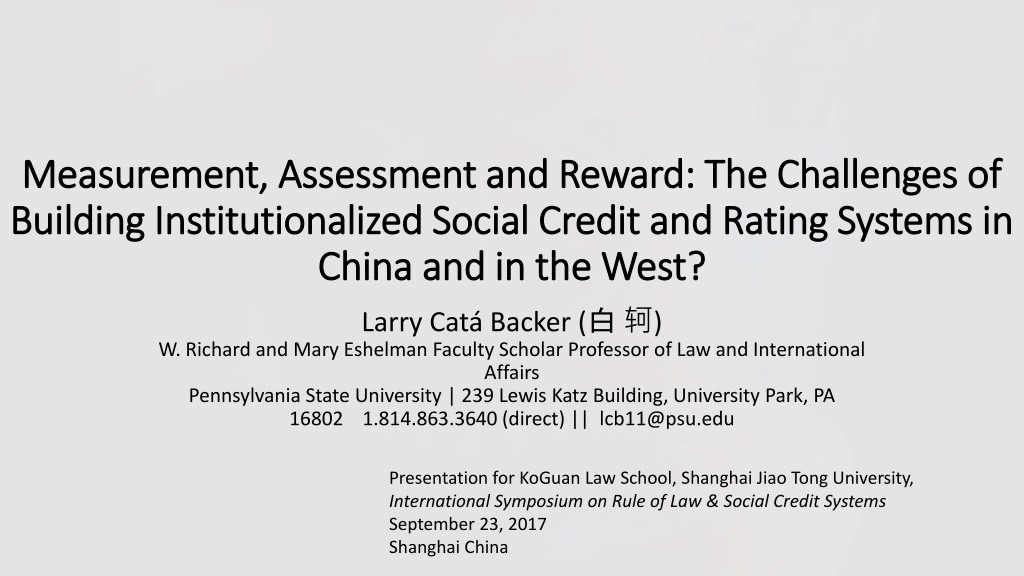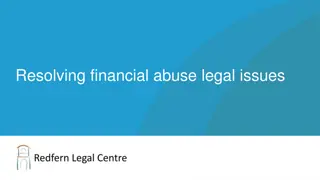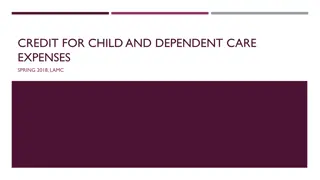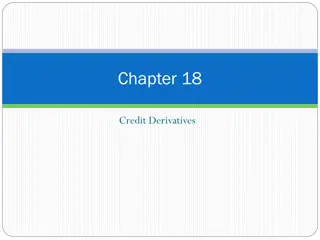Challenges of Building Social Credit Systems in China and the West
The presentation by Larry Cat Backer explores the challenges of constructing institutionalized social credit and rating systems in China and the West. It delves into the intricacies of measuring, assessing, and rewarding individuals and entities based on criteria like governmental sincerity, commercial integrity, societal trustworthiness, and judicial credibility. The Chinese social credit system is operationalized across various sectors, influencing governmental actions, commercial activities, social integrity, and judicial credibility.
Download Presentation

Please find below an Image/Link to download the presentation.
The content on the website is provided AS IS for your information and personal use only. It may not be sold, licensed, or shared on other websites without obtaining consent from the author. Download presentation by click this link. If you encounter any issues during the download, it is possible that the publisher has removed the file from their server.
E N D
Presentation Transcript
Measurement, Assessment and Reward: The Challenges of Measurement, Assessment and Reward: The Challenges of Building Institutionalized Social Credit and Rating Systems in Building Institutionalized Social Credit and Rating Systems in China and in the West China and in the West? ? Larry Cat Backer ( ) W. Richard and Mary Eshelman Faculty Scholar Professor of Law and International Affairs Pennsylvania State University | 239 Lewis Katz Building, University Park, PA 16802 1.814.863.3640 (direct) || lcb11@psu.edu Presentation for KoGuan Law School, Shanghai Jiao Tong University, International Symposium on Rule of Law & Social Credit Systems September 23, 2017 Shanghai China
Context: System Building Convergence and Divergence China West Social Credit An example of China s top-level design ( ) approach; coordinated by the Central Leading Small Group for Comprehensively Deepening Reforms. It is a project for the development of a national reputation system, assigning a social credit number that reflect a qualitative judgment of relevant data gathered about the subject. will focus on four areas: "sincerity in government affairs" ( ), "commercial sincerity" ( ), "societal sincerity" ( ), and "judicial credibility" ( ). Ratings and assessment systems Most are private efforts Original: credit ratings Now rate virtually anything for which data is available Universities Corporate social responsibility State has become involved Compliance systems Not ratings per se but Assessment Guide to exercise of administrative discretion (Department of Justice and corporate corruption)
Chinese Social Credit: Operationalization Focus on four sectors Government, commercial activities, social integrity, judicial credibility II(1)-(4) (1) government; Social credit as trigger for variety of governmental action: administrative permission, government procurement, tendering and budding, labour and employment, social security, scientific research management, cadre promotion and appointment, management and supervision, application for government financial support and other such areas, and foster the development of a credit services market. Honor government agreements and commitments Monitor civil servants
Chinese Social Credit: Operationalization (3) Social integrity Healthcare, birth control, hygiene Social Security Labor and employment Education and scientific research Culture, sports, tourism Intellectual property rights Environmental protection Credit records for natural persons in economic and social life Internet application and services (4) Judicial Credibility Transparency in proceedings Prosecutorial credibility Public Security services credibility Judicial administrative systems Law enforcement standardization (2) commercial activity; Production Logistics Finance. Taxation Pricing ( clear retail pricing ) Project construction Government procurement Tendering and bidding Transportation E-Commerce Statistics Services sector (Professionals) Advertising Enterprise governance (including CSR)
Objectives: A First Run at Applied Systems Theory This short essay has two objectives. The first is to examine the challenges that social credit, ratings or assessment systems pose for effective implementation. The second is to examine some aspects of Western rating and accountability systems to consider resonances with Chinese social credit.
Order of Discussion Technical and Normative challenges to Social Credit Construction difficulties of separating the role of social credit as a set of techniques and as a means of advancing ideological principles and objectives. social credit as a project of informatics. control element of social credit systems, and social credit as governance. Resonance With Western efforts The ways in which Western efforts at social credit institutions have sought to meet the technical and normative challenges identified above the context of social credit systems in the West, and its operationalization, principally in the private sphere. It examines the use of social credit as a technique of governance and as a means of embedding international standards in domestic behavior.
Technical and Normative Challenges to Construction of Social Credit or Ratings Systems Data Identification Effects Data Decision Collection Discretion Assessment Algorithm Rating
Social Credit: Systemic Challenges System Construction Challenges Different standards or forms for individuals, enterprises, officials Overall inter-systemic coordination; synergy effects System integrity and audit Data relevance Management Problems Coherence across a vast governmental sphere Integration with private social credit offshoots How to solve issue of administrative abuse Integration with political and systems standards outside of China Political issues Integration with core political line inside China internal versus external applications; especially enterprises Overall policy coherence and coordination Technical Issues Data harvesting Data retention Data integrity Review mechanism itself a subject of or corrupted by the social credit system in which it is embedded? Interpretation Challenges Adding meaning to data may be difficult Algorithms
Social Credit as Norm and Technique Normative Context: Compliance is a function of both observation and the knowledge of being observed Substantive Values are what you measure, what you measure are values Conformity to underlying normative assumptions, but surveillance itself evolves those assumptions Implementation First movement, from an assumption that surveillance and monitoring is a passive response to bad conduct to an active principle: that surveillance is an essential component of any normative system. Surveillance normativity thus posits that law is not self-enforcing. Legal subjects must be made to obey. They are no longer presumed to do so unless evidence to the contrary is produced. And that compulsion no longer comes at the point of a gun or in the uttering of individual representations of the legitimate authority of the state. Instead, it comes through the gaze; systems of constant observation combined with a self-awareness of being constantly observed that together coerces a particular set of behaviors tied to the character of the observation. The second movement involves the relationship between implementation surveillance normativity and individuals. It is perhaps best understood in the context of the rise of a social duty of loyalty at every level of the social order (acting for the benefit of the organization rather than for personal benefit) and the consequential focus on corruption. .
Social Credit as Informatics From Data to Information: Evaluation Conversion from data to information Two way relationship between data collection and the objectives of collection Sufficiency Issues: Verification; Management Exposure Confession Broadcasting data Active element of surveillance The power of secret and public information Coherence and Legitimacy Is there a connection between the data, the interpretation and the judgement . Data Identification What is raw information? What is judgment or conclusion? An easy example of this problem is race : is it raw data or is it a judgment? What is included in harvesting; what is excluded those decisions help color analysis and evidence normative bias or instrumental use of data. Data Collection issues Passive element (intake) Scope: what is collected Focus: how is it organized and distributed Capacity to collect: technical capacity to collect and use Analytical framework the algorithm Human or mechanical interpretation?
Social Credit as Control Locating the power to Determine the Contours of Information Production. Centralized power (all decisions made by a central authority) Decentralized: within or outside the state. Assigning Responsibility for the Production of Information Active production of data reporting obligations Passive harvesting Controlling access to data and interpretation algorithms. Determining the use of information Raw data up to controlling institution Judgment and consequences down from controlling institution
Social Credit as Governance Gouvernmentalit , a linking of governance with the techniques of its power Policing (by the social credit manager) and compliance (by the social credit data producers) appear to have become a primary focus of governance In Federal Securities Law: That ultimate regulator, the federal government, selects the data to be gathered, deploys corporate outsiders to monitor internal surveillance efficiencies, defines the boundaries of effective analysis (that is of analysis with legal effects), and selects the judgment to be made from certain clusters of information, but not from others. . Surveillance here in its normative/regulatory guise confronts the issues: Is there an ideal from which deviations can be judged? And at what point is deviation severe enough to merit discipline and correction? The answer increasingly appears to be no. . . and yes! Produce resistance using similar techniques For example, the control of crowds and mass protests through the techniques of surveillance has been met by evolving techniques of resistance based on the same techniques deployed to control crowds. Form of Governmentailty follows the normative basis for political organization. In the West that governance power of surveillance and control has fractured In China it is going in the opposite direction.
Western Approaches to Social Credit: Principles Law Enforcement Method Alternative to administrative regulation as a tool of lawmaking Transparency Engagement For governance Information For consumer choice Controlling behavior Organizations Individuals Shaping culture Health and wellness Social vices (drinking, sexual activity, etc.) Accountability Individuals Entities government
Western Approaches to Social Credit: Operationalization Public Sphere Licensing and review programs Educational institutions Professional services (from hairdressers to lawyers) Data sharing Child support Sexual predators Criminals Monitoring and disclosure Securities Rating Credit rating Corporate CSR rating
Western Approaches to Social Credit: Operationalization Private Sphere Credit rating agencies Individuals Enterprises Governments News Media Education institutions (London Time; U.S: News) Academics; Think Tanks Impact assessment metrics Industry sector performance Enterprise systems Eugenics Social media
Future Work Can social credit be understood within the cage of the CCP basic line OR To what extent might aspects of the basic line provide an insight into both the character and operation of social credit How to situate Social Credit within the larger context Socialist modernization The role of a vanguard party How to situate it within a more granular context The construction of socialist law The relationship between the framing of algorithm and data harvesting How to situate it within a theoretical context The conception of socialist law Framing behavior or putting a cage around the exercise of administrative discretion? Developing the CCP Basic Line How to situate it within its technical constraints Pragmatic issues of data, algorithm and policy coherence
Concluding Thoughts Social Credit is much more than technique or rating system; The Mass Line may have something to say to both the framing and management of social credit as a political tool and as an expression of law. The ideal of the mass is changing reinforcing the movement from class struggle as the basis for collectivity to socialist modernization Social Credit may fundamentally change the way one thinks about the exercise of the leadership role of the CCP. Data and algorithm Be sensitive to the normative element of data, and The ideological element of algorithms
Thanks! Thanks! Additional Readings by Larry Cat Backer: From a Two Thrust Approach to a Two Sword One Thrust Strategy to Combat Criminal Corruption: Corporate Compliance, Prosecutorial Discretion, and Sovereign Investor Oversight Jilin University Journal, social science edition (forthcoming 2017) . Theorizing Regulatory Governance Within its Ecology: The Structure of Management in an Age of Globalization, Contemporary Politics 23:--- (Special Issue forthcoming 2017). Transparency Between Norm, Technique and Property in International Law and Governance The Example of Corporate Disclosure Regimes and Environmental Impacts, Minnesota Journal of International Law 22:1-70 (2013) Global Panopticism: Surveillance Lawmaking by Corporations, States, and Other Entities, Indiana Journal of Global Legal Studies 15(1):101-148 (2008); Monitor and Manage: MiFID and Power in the Regulation of EU Financial Markets, Yearbook of European Law 27:349-386 (Oxford U. Press, 2008)























